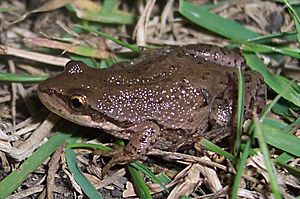Boreal chorus frog facts for kids
Quick facts for kids Boreal chorus frog |
|
|---|---|
 |
|
| Conservation status | |
| Scientific classification |
The boreal chorus frog (Pseudacris maculata) is a small frog that lives in many parts of Canada and the United States. You can find it from central Quebec to eastern British Columbia in Canada. In the USA, it lives in states like Montana, Arizona, and New Mexico. These frogs are known for their special calls, especially in spring.
Contents
What Does the Boreal Chorus Frog Look Like?
This little frog is only about 30 millimeters (about 1.2 inches) long. It can be brown, or sometimes green, on its back. It usually has three broken stripes on its back. These stripes can be very clear or hard to see. A dark line runs from its nose, across its eye, and down its side.
The boreal chorus frog has slightly bigger toe pads. These help it climb small plants and grasses. It looks a lot like the western chorus frog. But you can tell them apart because the boreal chorus frog has shorter legs.
Where Do Boreal Chorus Frogs Live and What Do They Do?
You can find these frogs near water, like ponds or puddles. They live in both open fields and forests. Male frogs make a "reeeek" sound from April to September. They call from plants or the ground near the water.
Each frog's call is a bit different. It's like they have their own special song. These calls help them find other frogs. They also tell other males to stay away from their spot. This frog is often one of the first amphibians to appear in spring. You might even see them when there's still snow and ice around! They come out when the snow melts and water levels rise.
Breeding and Life Cycle
Boreal chorus frogs usually breed once a year. This happens when the weather gets warmer, usually from late February to April. After mating, a female frog can lay between 500 and 1,500 eggs.
The eggs hatch into tadpoles around June or July. These tadpoles then change into small frogs. This change is called metamorphosis. Many tadpoles survive this change and become adult frogs.
What Dangers Do Boreal Chorus Frogs Face?
Frogs and other amphibians are very important for their environments. But many amphibian populations around the world are shrinking. There are several reasons why this is happening.
Threats from Climate Change
One big problem is climate change. This is making the weather drier in many places. Dry weather is hard for most amphibians, including the boreal chorus frog. It means they have to change how they act. Sometimes, they end up in places that are not good for them.
Lower water levels due to dry weather also cause problems. The frogs and their eggs, which are laid in the water, are exposed to hotter temperatures. Also, less water means more UV radiation from the sun reaches them. This can harm the frogs and their eggs.
Learning to Avoid Predators
Boreal chorus frogs have a cool way to defend themselves. They can learn how to act around predators. This is called "cultural learning." It means young tadpoles can watch older tadpoles and learn to avoid dangers. For example, if a new predator, like an invasive fish, comes into their home, it takes time for the tadpoles to learn to avoid it. This can put more stress on the frog population.
Threats from Fungus
A dangerous fungus called Batrachochytrium dendrobatidis (Bd) is infecting amphibians worldwide. The boreal chorus frog can also get this fungus. Bd attacks the frog's skin. This makes it hard for the frog to control the water in its body. Some frogs might not seem affected, while others can die.
Scientists are studying how boreal chorus frogs deal with this fungus. Some studies show that the frogs are struggling. Others show that some populations are doing okay. It's a mystery because up to 80% of infected frogs can die.
The Bd fungus is tricky because it can live in the environment even without frogs. It can survive in water for a long time. It can also stick to things like bird feathers. This means the fungus can stay in a place and keep infecting new frogs. Tadpoles can get infected on their mouths, and adult frogs can get infected almost anywhere, especially on their toes.
Salamanders can also carry the Bd fungus. This is important because salamanders can keep the fungus alive in the water, even during winter when frogs live on land. This means boreal chorus frogs in areas with infected salamanders might always be at risk of getting the disease. This could be why some populations are declining.
See also
 In Spanish: Pseudacris maculata para niños
In Spanish: Pseudacris maculata para niños


